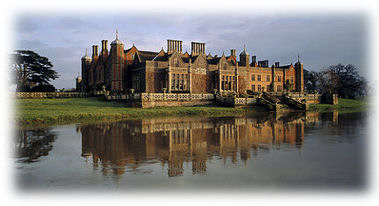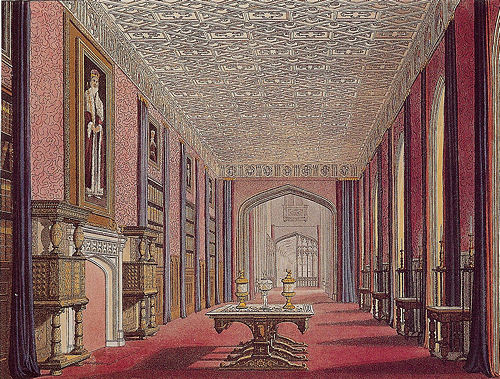| |
 |
|
Charlecote
Park
|
The Borghese Table
I
had a number of replies to my query about the Borghese table:
I
asked: We know that William Beckford acquired the Borghese table
in Paris and had it transported to Fonthill Abbey. As he made several
trips to Paris does anyone know the date of the acquisition? Was it
at Fonthill for the visit of Nelson in 1800?
From:
Derek C Tilford
Hi Len,
I have just read your request for info relating to the Borghese table
and when Beckford acquired it.
Two years ago, members of the Beckford Society descended on Charlecote
with the aim of identifying the items that George Hammond Lucy
purchased at the Fonthill Abbey auction in 1823. They had with them
a set of notes, which as the guide in the Hall, I noticed they were
using as a reference. Being able to answer a number of their questions
I asked whether, when they had finished in the house, I could have a
copy of their notes.
You may be interested in the following which referred to the Borghese
table in these notes:
The ‘Borghese' Table.
This 16th century slab of pietre dure was supposedly removed from the
Borghese Palace in Rome and taken to Paris during the Napoleonic campaign
in Italy. After purchasing it in Paris, Beckford then had the oak frame
or base designed in the Elizabethan or Gothic style to suit its placement
in the King Edward's Gallery at Fonthill Abbey. There is, however, very
little evidence detailing how and when Beckford actually purchased it.
The pattern of precious stones, oriental onyx and jaspers set in geometric
borders of arabesques is typical of the late 16th and 17th century Roman
work, which suggests that the story of it being in the Borghese Palace
is probably true.
Not only is this perhaps the most famous of all Beckford's furniture,
it is also one of the greatest examples of pietre dure in the world.
Its size, design and the Borghese provenance led to Lucy purchasing
the table in 1823 for £1890, over half of the total amount he spent
at the sale.
What I found interesting was a picture in these notes. I am oftened
asked whether the table was ever used as a table. The picture in these
notes shows the table in the King Edward's Gallery at Fonthill Abbey
and it shows three objects placed on the table.

The
table in the King Edward Gallery, Fonthill
Another item of interest in these notes is a reference to oak tables
in the picture of the Galleryl. It states that there were only four
Oak Tables listed in the auction, they being sold as pairs in 1823 for
£16.5.6d. It is thought that Lucy had two extra tables made to match.
I have looked closely at all the tables at Charlecote and it is not
evident which are the extra two tables. Knowing the expertise of James
Wilcox and his mastery at carpentry, it would not surprise me if he
had a hand in this exercise.
Derek
Thanks for the reply Derek although it does not add anything new unfortunately.
I thought there might be an inventory of what Beckford bought but if
the Beckford Society does not know then presumably no such inventory
exists.
Their description rather implies that Napoleon took the table by force.
However in 1803 Napoleons youngest daughter, Pauline, married Prince
Camillo Borghese so there was a family connection and he may have just
acquired the table that way. I don't know where it was kept in Paris.
Len
When telling the story of the table I always say "how it got from
the Palace in Rome to Paris is a mystery, some assume that as Napoleon
was roaming Europe on his campaigns, he saw it and as was his want,
it followed him to Paris, however I point out, because of the marriage
of a member of his family into the Borghesa family, he could have had
a legitimate claim on it"
I seem to remember being told way back, that Beckford sighted the table
in Paris while on his travels in the 1790s and purchased it, pointing
out that when buying the table he only purchased the top, getting the
legs made for him when he got it back to Fonthill Abbey.
It was interesting touring Madrid a couple of year ago with our U3A,
to see two small pietre dure tables in the Prado Musuem. One of the
tables which had some similarities to the Charlecote table, was described
as made by Florentine craftsmen and was listed in an inventory of the
Arsenal at Segovia in 1624. Comparing the two tables, because of similarities
in design, you could almost believe that the same craftsmen had worked
on both tables.
Derek C Tilford
Charlecote Guide - Saturday team
Ted (or Anne) also told me that Napoleon put the table top on
a gun carriage to take it over the Alps rather than by sea. I always
tell that story and that Pickfords brought it by barge to Stratford
and then by cart to Charlecote.
Well closer to home, have you been to Powis castle? There is a table
there that has an identical pattern to ours (as far as memory can be
trusted) but I thought it slightly smaller. The workmanship is crude
compared to ours and Ted and I discussed it and came to the conclusion
that it might have been an apprentice piece.
Len
I have always been aware of the second table at Powis Castle. We were
told about it by George Shears and the history of the two tables when
I first started at Charlecote.as part of our 'indoctrination'
That second table was an insurance by the artisans in Florence who realised
that the Borghese commission was very important. To cover themselves
in case anything went wrong with the main table, that was destined for
the Borghese Palace, the artisans had the apprentices learning the trade
by working on a second identical table. If anything untoward happened
with the prime table eg base marble cracked, all the artisans would
have needed to do would have been to swing over onto the second table
and continue without loss of too much time.
As it turned out the artisans table was perfect, and on completion was
sent down to the palace in Rome. In theory the second table should then
have been smashed up as the Borghese's expect special items that they
order to be unique. Obviously with a copy around, the artisans had a
problem.. They reasoned that as the Borghese's didn't know about the
second table there wasn't a problem at present. If the Borghese's never
heard about the second table the artisans were on to a winner if they
managed to secrete it away, with the possibility of making a few extra
bucks (sorry lira) on the way.
So they managed to arrange for the table to be taken to England where
it was obtained in the 1620s by the Clive family. They wanted to place
it in the long gallery at Powis, but weighing approx two tons it was
too heavy for the floor. Instead they had an extension to the long gallery
built and the table was placed in the extension before they installed
the windows. Then they had another problem, with the object weighing
2 tons, what was strong enough to support the weight of this table top.
The answer was a four poster bed structure that was inverted with a
couple of extra posts added to support the table. That is what was used
and that is where it has remained - upstairs in the extension at the
end of the long gallery
I revisited Powis a couple of years ago when returning from visiting
my daughter on Anglesey. Seeing the table again after a period of some
ten years, I was surprised at the finish of the table. It looked as
if someone had painted a coating of varnish over the top surface which
had become pitted. I did not remember it like that previously.
I asked the room steward whether anything had been done to the table
recently and she assured me that as far as she knew, it had always been
like that.. The structure under the table is obviously quite different
from that made by Beckford, but at Powis, as I talked to the steward,
children were playing in the box space under the table. Also I was amazed
on questioning the steward, she was not aware that there was a second
table at Charlecote. As far as I know, the second table is as near to
the size of the original as possible, as it would have needed to conform
to the original Borghese specification.
In order to transport the table top it is supported by wooden crating
but carried on its side, in this way it will not flex and crack or break.
Yours aye,
Derek
I am not so sure about this. Both Ted and I feel the table at Powys
is smaller. The work is decidedly inferior so could never have been
passed off as the real thing. It also lacks the central onyx. We think
it was just an apprentice piece. Clearly some measurements are required.
And
a communication from Stewart Scott
Dear
Len,
In
connection with your enquiry about the Beckford table.
This is not directly
about the table but it may interest you-you may of course already know!

I
recently visited Abbotsford - Sir Walter Scott's house in Scotland.
In the Library are 2 elaborately carved chairs.
'I
found two large elbow chairs in boxwood-perfectly entire. Mr Swaby assures
me that they came from Rome' says Scott's publisher Archibald Constable
in May 1822 and he then gave them to Sir Walter.
The
Abbotsford guide book then says,
'The
Abbe Celotti imported the chairs along with the Borghese Table for Fonthill
Abbey, and as they are in the style and quality of Brustalon, it is
more than likely that they came from his workshop.
This
made me wonder if the table and chairs were were shipped together and
Beckford had them together.
Last
year I went to Belvoir Castle and they have 6 chairs in the Picture
Gallery, that appear to be identical,
Their
guide book says,
'6
chairs, exquisitely carved from the Borghese Palace, Rome',
then
in a picture caption,
'chairs
1700-20 which were acquired for the 5th Duke from the Borghese
Palace in Rome in 1820'
So
was there a set of 8 chairs along with the table?
Stewart Scott
This
date may be too late see comments below
From
Ted and Anne Veich
Building
of Fonthill commenced 1796, original design by James Wyatt who was currently
working for King George III on ‘modernising’ Windsor Castle in te ‘Gothic’
style
Despite
England being at war with France, Beckford was given pwrmission in 1801
to travel to France where he rented Hotel Kinsky, a large house in Paris.
He lived there for about two years and there are records of his buying
furniture, pictures, Japanese ware and Ceramics.
I
have not been able to confirm when the King Edward III gallery was completed
at Fonthill but it was possibly after the visit to Paris.
There
are records that show that between 1810 and 1818 Beckford commissioned
several ‘Jacobean’ style items of furniture, some from James Wyattville,
including the four small oak tables currently at Charlecote and the
support for the Borghese table top.
There
is a possibility that the top was bought at auction in England as there
are records of sales in London. The Abbe Celotti was a dealer who worked
in London and Paris and is thought to have worked on behalf of Beckord
for some of his acquisitions. His speciality was the import of Italian
treasures.
|


